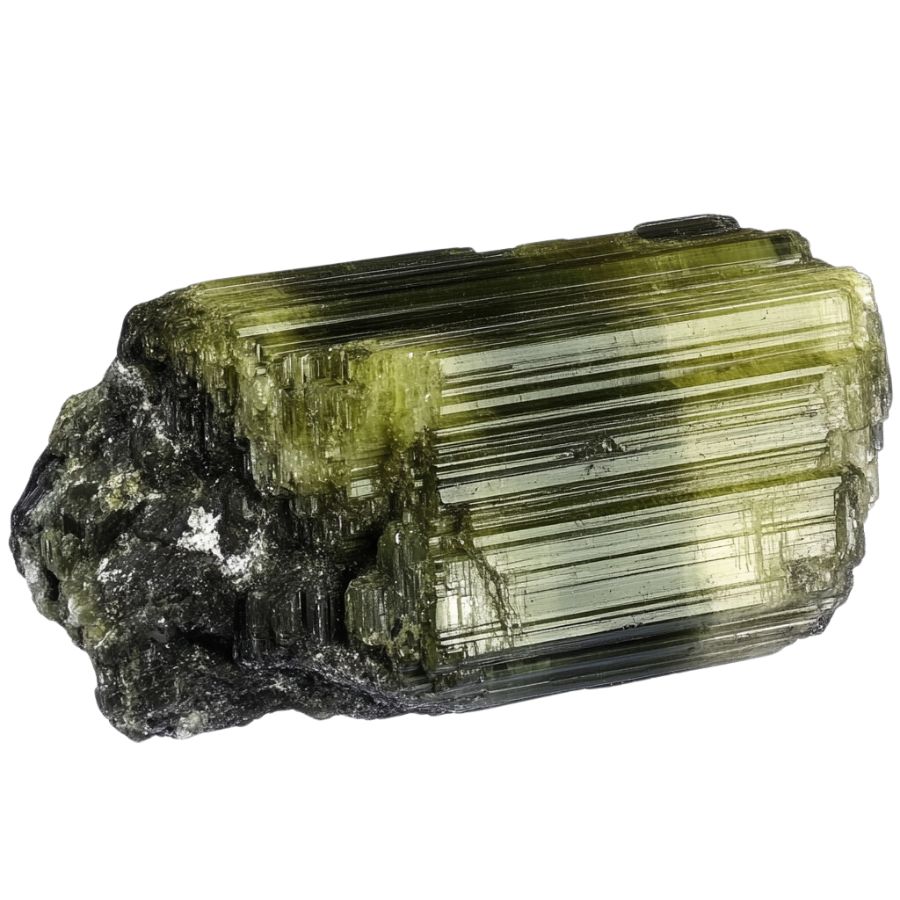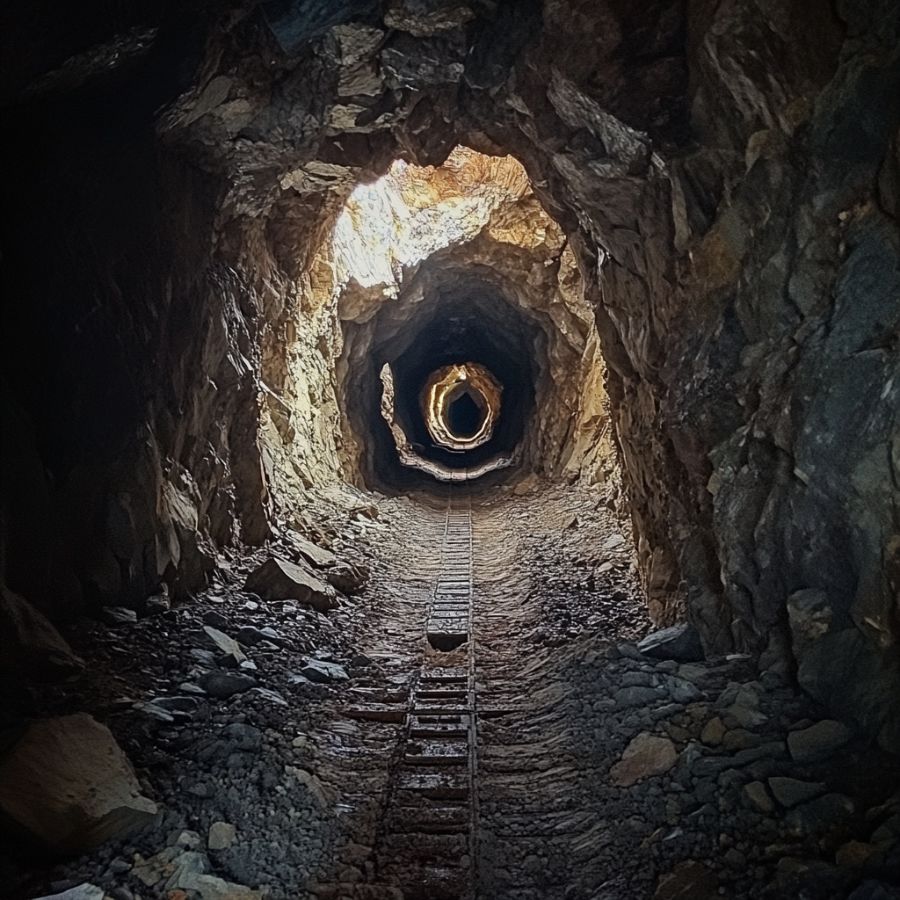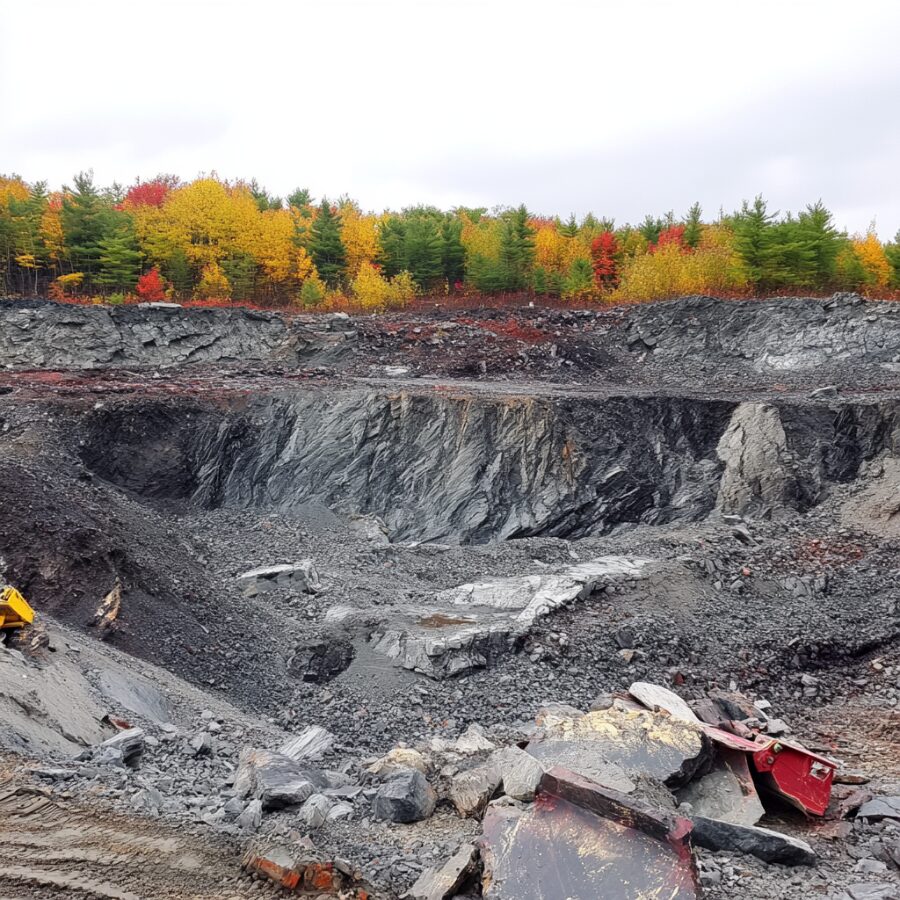From the Massachusetts border to the Connecticut River, from Maine’s rugged coast to Vermont’s Green Mountains, New Hampshire’s diverse landscape holds hidden treasures.
For rock hounds and gem enthusiasts, the search for tourmaline can be frustrating and time-consuming. Countless hours spent scouring the wrong locations can dampen even the most passionate collector’s spirit. But fear not!
We’ve done the hard work for you. We will reveal the best spots to find tourmaline in the Granite State.
Our carefully researched list will save you time and energy, ensuring your next expedition is both exciting and rewarding.
How Tourmaline Forms Here

Tourmaline forms deep underground through intense heat and pressure. It originates from hot, mineral-rich fluids that move through fractures in rocks like granite and pegmatite. As these fluids cool, the minerals within them start to crystallize, forming tourmaline.
The color of tourmaline depends on the specific minerals involved, leading to a wide range of hues including pink, red, green, and blue.
Over millions of years, these crystals grow and become the beautiful, multifaceted stones we see today. Tourmaline is prized for its variety of colors and is often used in jewelry and decorative items.
The Types Of Tourmaline
Several incredible types of Tourmaline can be found in the US as well as in our state. Each is uniquely beautiful and interesting including:
Elbaite

Elbaite is found in pink, red, green, blue, yellow, and even colorless forms. What makes elbaite special is its ability to show multiple colors in a single crystal, like the famous “watermelon” tourmaline with pink and green hues.
This gem stands out due to its complex chemical makeup, which includes lithium, sodium, and aluminum. This composition gives Elbaite its diverse color range and dichroism, allowing it to display different colors when viewed from different angles.
Elbaite has a unique place in history as the first tourmaline variety in which lithium was discovered back in 1818. Some rare types, like the neon blue Paraiba elbaite, are highly sought after by collectors and jewelers.
Schorl

Schorl is known for its deep, rich color. It typically forms long, prismatic crystals with a shiny, glass-like surface when polished. Unlike other tourmalines, schorl gets its distinctive black color from high iron concentrations.
One of Schorl’s most fascinating features is its ability to become electrically charged through heating or rubbing. When charged, it can attract or repel small particles.
This unique electrical property makes Schorl valuable in various industries. It’s used in electronics and manufacturing to control static electricity and electromagnetic interference.
Despite being less colorful than other tourmalines, schorl’s practical applications make it an important and interesting variety.
Rubellite

Rubellite stands out with its vibrant pink to red colors. The most prized ones show a pure, saturated red without any brown or orange hints. This beautiful color comes from manganese in its makeup.
One cool thing about rubellite is its double refraction. It can look like it has two different colors when you view it from different angles.
Dravite

Dravite, or Brown Tourmaline, comes in shades from dark brown to light brown-yellow. It can look a bit like Smoky Quartz, with a semi-see-through quality.
Its crystals are often needle-like or prismatic, with points at both ends. This sets it apart from other tourmalines like the darker schorl or the colorful elbaite.
What makes dravite special is its rich sodium and magnesium content. This sets it apart from other tourmalines. It was first discovered in 1883 and named after the Drava River in Slovenia.
Indicolite

Indicolite is a rare and captivating blue to blue-green stone. It’s prized for its pure, bright blue color, which is considered the rarest within the tourmaline family. The hues can range from light blue-green to deep, rich blue, often with high clarity.
What sets Indicolite apart is its unique optical effects. It shows pleochroism, appearing to change color when viewed from different angles. Some specimens also display chatoyancy, creating a “cat’s eye” effect when cut in a certain way.
Indicolite is sometimes called “Brazilian sapphire” due to its resemblance to the precious gem. However, they’re different minerals.
The increasing demand for blue tourmalines has made indicolite highly sought-after in the gemstone market, appreciated for its beauty and rarity.
Watermelon Tourmaline

Watermelon tourmaline is truly one-of-a-kind. It looks just like a slice of watermelon, with a pink or red center and a green outer layer. This unique look happens because different elements join the crystal at different times as it grows.
These crystals often form in a rounded triangle shape. They’re see-through to somewhat clear and have a glass-like shine. When cut into slices, they really do look like little watermelons!
Cat’s Eye Tourmaline

Cat’s eye tourmaline is known for its mesmerizing chatoyancy effect. This creates a bright band across the stone’s surface, resembling a cat’s eye.
This stone comes in various colors, from green to pink to brown, and is usually semi-translucent to opaque.
What makes this stone special is the perfect alignment of tiny, needle-like inclusions inside it. These scatter light in a unique way, creating that eye-catching effect. It’s quite different from other tourmalines that don’t have this feature.
Unlike other cat’s eye stones, Tourmaline offers a wider range of colors and is often more affordable.
Achroite

Achroite is a rare, colorless variety of tourmaline that looks like a drop of clear water turned to stone. It’s completely transparent, making it unique among tourmalines which usually have color. The name comes from Greek, meaning “without color.”
What’s special about achroite is that it doesn’t change color when viewed from different angles. It means the stone can be cut in many ways without losing its clarity.
Verdelite

Verdelite is known for its beautiful green color. It can range from light green to deep emerald.
One thing that makes verdelite special is that you can find big, clear crystals of it. This isn’t always easy with other gemstones.
People love using verdelite in jewelry because its rich color and interesting light effects make it a popular choice for all kinds of accessories. Each piece of verdelite is like a little piece of nature you can wear.
Paraíba Tourmaline

Paraíba Tourmaline is a rare gemstone that catches the eye with its vibrant neon blue or green color. It’s like no other tourmaline you’ve seen before. The intense glow comes from copper in the stone, making it stand out from its cousins.
This stone is one of the rarest. For every 10,000 diamonds mined, only one Paraíba tourmaline is found.
It was only discovered in the late 1980s, making it a newcomer in the gem world. But Paraíba tourmaline’s unique color and rarity quickly made it a favorite among gem lovers.
Its discovery caused quite a stir in the gem community. Even small stones can be valuable because of how rare and beautiful they are.
What Rough Tourmaline Looks Like
When you’re out looking for rough Tourmaline on your own it’s important to know what you’re looking for. But before we dive into specifically what to look for you need to make sure you understand the type of rocks and minerals you’re seeing.
DON'T MISS OUT ON ANY GREAT FINDS!
While you're out searching for Tourmaline you're going to find A LOT of other interesting rocks and minerals along the way. The last thing you want to do is toss out something really interesting or valuable. It can be easy to misidentify things without a little guidance.
We've put together a fantastic field guide that makes identifying 140 of the most interesting and valuable rocks and minerals you will find REALLY EASY. It's simple to use, really durable, and will allow you to identify just about any rock and mineral you come across. Make sure you bring it along on your hunt!
Now, back to the identification specifics:
Here are some tips to help you recognize rough tourmaline.
Look for Color Variations

Tourmaline comes in many colors, like pink, green, blue, and even black. Some pieces have multiple colors, like watermelon tourmaline, which is pink and green.
If you see these color mixes, it’s likely tourmaline. Keep an eye out for vibrant shades.
Assess the Density and Weight

Rough tourmaline is relatively heavy for its size. If you pick up a piece and it feels denser than expected, it could be tourmaline. This weight can help you confirm your find.
Examine the Crystal Structure

Tourmaline features distinctive crystal shapes, ranging from slender and elongated to chunky forms. Look for triangular cross-sections and striations on the surface, which indicate its unique growth patterns.
Check for Transparency

Some rough tourmaline can be slightly transparent. If you hold it up to the light, you might see through it a bit. This transparency can be a good sign that you have tourmaline.
A Quick Request About Collecting
Always Confirm Access and Collection Rules!
Before heading out to any of the locations on our list you need to confirm access requirements and collection rules for both public and private locations directly with the location. We haven’t personally verified every location and the access requirements and collection rules often change without notice.
Many of the locations we mention will not allow collecting but are still great places for those who love to find beautiful rocks and minerals in the wild without keeping them. We also can’t guarantee you will find anything in these locations since they are constantly changing.
Always get updated information directly from the source ahead of time to ensure responsible rockhounding. If you want even more current options it’s always a good idea to contact local rock and mineral clubs and groups
Tips on where to look
Once you get to the places we have listed below there are some things you should keep in mind when you’re searching:
Look for Sedimentary Rocks

Sedimentary rocks are great places to find tourmaline. These rocks form from layers of sand, mud, and minerals. Over time, minerals like tourmaline can get trapped.
Look in riverbeds or areas where sediment has built up. You might find small pieces or even larger crystals.
Explore Mines

Mines are great spots to find tourmaline. Many mines across the U.S. extract various gemstones, including tourmaline.
Some mines even allow visitors to search for gems themselves. Always check if they have guided tours or special digging days.
Search in Gravel Pits

Gravel pits are often overlooked, but they can be treasure troves. These pits dig deep into the earth, exposing layers of rock.
Tourmaline can be found in the gravel. Just sift through the material carefully.
The types of Tourmaline can you find around the state
New Hampshire is home to various types of tourmaline, with schorl and watermelon tourmaline being the most notable.
Schorl, a black variety of tourmaline, is the most common type found in the state. It typically appears in pegmatitic formations and can be identified by its dark coloration, which ranges from brownish-black to pure black.
Watermelon tourmaline is a unique and visually striking variety characterized by its pink and green coloration, resembling a watermelon slice. This bi-colored tourmaline forms due to varying conditions during its crystallization process, leading to distinct layers of color.
Some Great Places To Start
Here are some of the better places in the state to start looking for tourmalines:
Always Confirm Access and Collection Rules!
Before heading out to any of the locations on our list you need to confirm access requirements and collection rules for both public and private locations directly with the location. We haven’t personally verified every location and the access requirements and collection rules often change without notice.
Many of the locations we mention will not allow collecting but are still great places for those who love to find beautiful rocks and minerals in the wild without keeping them. We also can’t guarantee you will find anything in these locations since they are constantly changing.
Always get updated information directly from the source ahead of time to ensure responsible rockhounding. If you want even more current options it’s always a good idea to contact local rock and mineral clubs and groups
Monadnock Mountain

Monadnock Mountain, standing tall in Jaffrey, is a rockhounding gem. This prominent peak, about 38 miles southwest of Concord, is famous for its unique geological makeup.
The mountain’s schist and quartzite composition, dating back 400 million years, creates a diverse mineral environment perfect for treasure hunters.
Tourmaline seekers will find the summit and higher elevations particularly promising. These areas, stripped of vegetation by historical fires, expose more bedrock.
The White Arrow Trail offers great access to these prime spots. As you climb, keep an eye out for rocky outcrops – they’re often hiding spots for tourmaline.
Monadnock’s popularity extends beyond rockhounding. It’s one of the most climbed mountains in the world, second only to Japan’s Mount Fuji. Its bare, rocky top provides stunning 360-degree views of the surrounding landscape.
While searching for tourmaline, you might also stumble upon other minerals like garnet or quartz, adding to the thrill of the hunt.
Holts Ledge

Holts Ledge is a striking cliff that’s part of the Dartmouth Skiway in eastern New Hampshire. This prominent geological feature offers more than just breathtaking views – it’s a treasure trove for rockhounds seeking tourmaline.
The ledge’s diverse rock formations, shaped by ancient geological processes, create an ideal environment for mineral enthusiasts.
Tourmaline hunters should focus their search along the cliff areas and surrounding trails. Natural erosion often reveals hidden gems near exposed rock faces.
The Appalachian Trail, which passes through this area, provides excellent access points for exploration. Keep an eye out for the characteristic prismatic crystals of tourmaline, which can vary in color from black to pink.
Wilton Crushed Stone Quarry

Nestled in southern New Hampshire, the Wilton Crushed Stone Quarry is an expansive site that spans across Wilton and Lyndeborough. The quarry’s claim to fame is its diverse mineralogy, making it a hotspot for tourmaline hunters.
What makes this location special is its rich geological tapestry. The quarry walls reveal complex rock formations and mineral veins, hinting at a fascinating geological past.
Alongside tourmaline, you might stumble upon anatase and fluorite, adding excitement to your search.
To find tourmaline, focus on the exposed rock faces and scour the loose material at the quarry base. The extensive workings provide countless nooks and crannies to explore.
Melvin Mountain

Melvin Mountain stands at an impressive 2,165 feet above sea level in the northeastern part of New Hampshire. This rocky giant is a treasure trove for mineral enthusiasts, especially those seeking tourmaline.
The mountain’s claim to fame? It’s the type locality for graftonite, a rare phosphate mineral that puts Melvin on the map for rockhounds worldwide.
What makes Melvin Mountain a hotspot for tourmaline hunters is its granite pegmatite formations. These geological wonders create the perfect environment for mineral growth.
The south side of the mountain is particularly rich in mineral deposits, offering the best chances for finding tourmaline.
As you explore, keep an eye out for pegmatite veins scattered throughout the mountain. These veins often contain pockets where tourmaline crystals form.
The diverse mineral composition of Melvin Mountain means you might stumble upon other fascinating finds while searching for tourmaline, making each expedition a potential multi-gem adventure.
Warren Area

Warren area is located in the western part of the state, within the White Mountain National Forest. The town includes the village of Glencliff and is crossed by the Appalachian Trail.
Warren’s diverse geology makes it a rockhound’s paradise, with the Baker River cutting through its landscape.
Tourmaline enthusiasts flock to Warren for its rich mineral deposits. The town’s granite and pegmatite veins are particularly promising for finding this colorful gemstone.
These areas are often accessible through hiking trails within the White Mountain National Forest, providing ample opportunities for rockhounding enthusiasts to explore and discover this beautiful stone.
Places Tourmaline has been found by county
After discussing our top picks, we wanted to discuss the other places on our list. Below is a list of the additional locations where we have succeeded, along with a breakdown of each place by county.
| County | Location |
| Cheshire | Chickering Mine |
| Cheshire | Hinsdale Area |
| Cheshire | Osgood Graphite Mine |
| Cheshire | Winchester |
| Grafton | Buffum Mine |
| Grafton | Kilton Mica Quarry |
| Grafton | Ruggles Mine |
| Grafton | Nancy No. 1 and 2 Quarries |
| Grafton | Rice No. 32 Prospect |
| Grafton | Palermo No. 1 Mine |
| Grafton | roadcuts and gravel pits of Littleton Area |
| Grafton | Orange area creeks |
| Grafton | Williams Mine |
| Grafton | Archertown Brook Occurrences |
| Grafton | Cottonstone Mountain Mine |
| Grafton | Eastman Ledges in Orford |
| Grafton | Northey Hill Line Occurrences |
| Grafton | Atwood Mine |
| Grafton | Wheat Mine |
| Grafton | Warren Area |
| Grafton | Clement Mine |
| Rockingham | Saddleback Mountain |
| Strafford | Barrington Area |
| Sullivan | Franklin Pierce lead mine |


